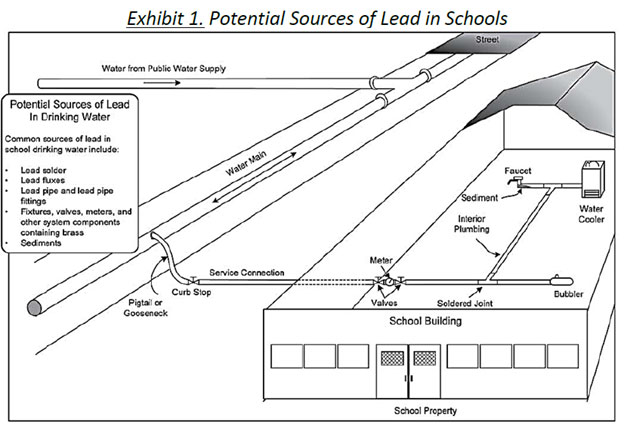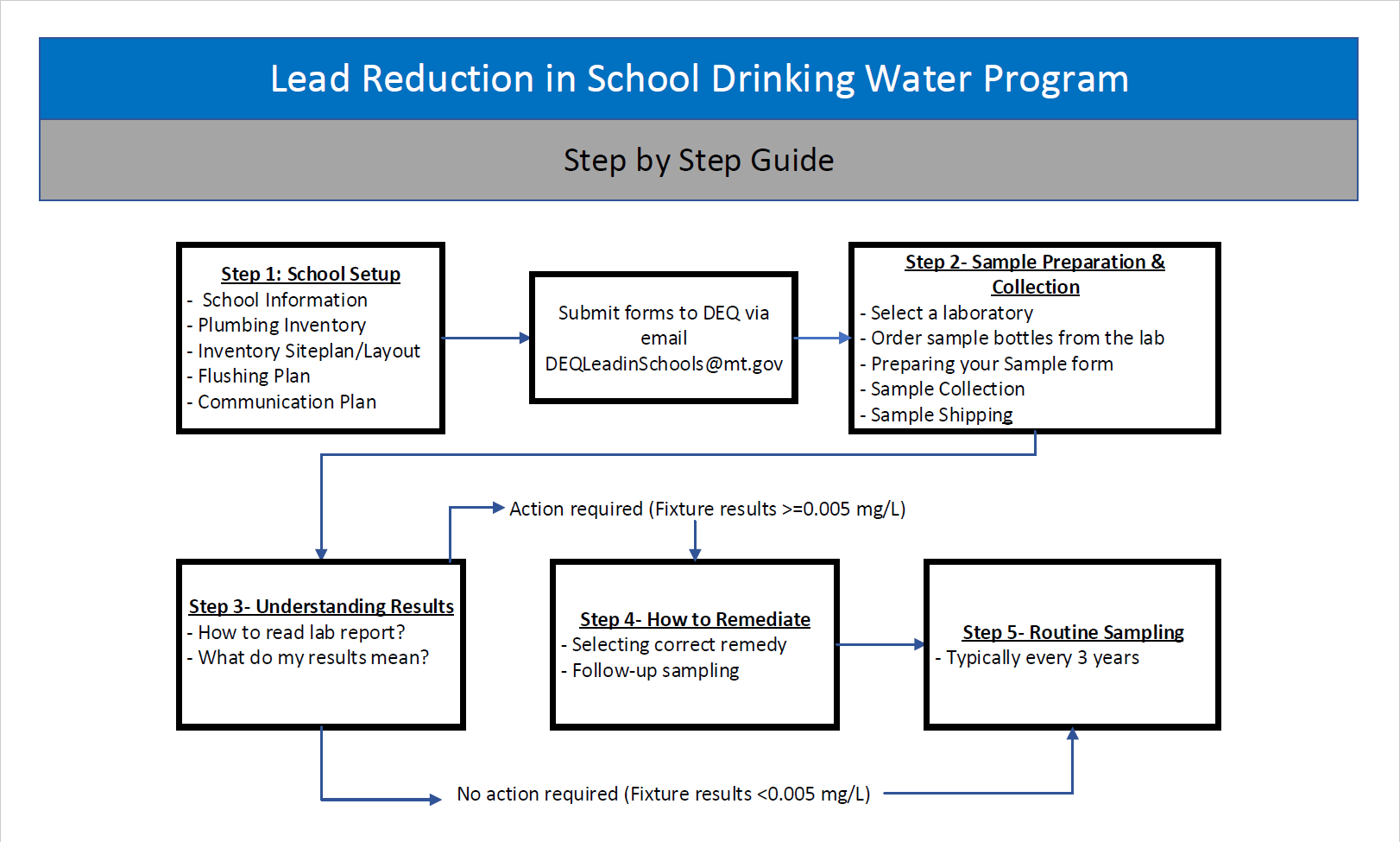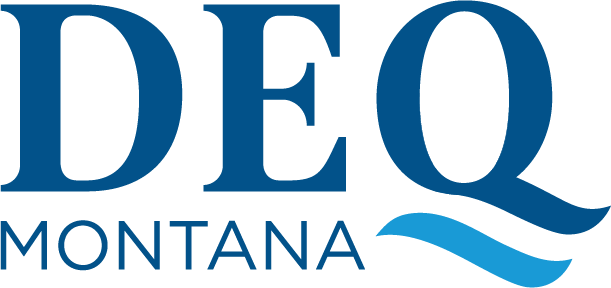Program Overview
This regulation was enacted Montana Department of Public Health and Human Services (DPHHS) to protect school children by minimizing lead levels in drinking water provided at Montana’s schools. Children are especially susceptible to lead exposure and spend a large amount of their childhood in schools. It is extremely important that schools are providing safe drinking water.
Montana Department of Environmental Quality (DEQ) is partnering with DPHHS to provide sampling and remediation technical assistance and guidance to schools.
Contacts
Lead Reduction in School Drinking Water Rule Manager
Greg Montgomery (406) 444-5312
1520 E 6th Ave
Helena, MT 59601
Send questions, comments, and documentation to DEQleadinschools@mt.gov
Program Overview
During the 2023 Legislative session, 3.7 million dollars for addressing lead in schools was included in House Bill 5. DEQ has developed a lead mitigation reimbursement program to help schools address lead in their drinking water. The reimbursement program will be available to all schools that are participating in the Department of Public Health and Human Services (DPHHS) Lead Reduction in School Drinking Water Program, which DEQ implements. The reimbursement program will be on a first come, first serve basis with a maximum reimbursement amount of $100,000 per school facility. The maximum amount may be adjusted in the future based on need and availability of funds.
Schools can apply for reimbursement through an online form located below.
Elementary & Secondary School Emergency Relief (ESSER) funding can also be used to address Lead in drinking water. Any remaining ESSER funds that have not been obligated to another activity must be used prior to applying for this reimbursement funding. Supporting information will be required to be submitted as part of the school reimbursement package.
Eligibility Criteria
- School must have collected their initial round of samples, and the results must have been submitted to DEQ.
- School accredited by MT Board of Public Education.
- Request must be associated with addressing lead in drinking water. This includes but is not limited to new water fixtures, filters, filtered bottle fill stations, auto-flushers, and replacement of lead containing plumbing materials. Labor costs are also eligible. Labor costs associated with collection of samples are also eligible.
- Maximum reimbursement of $100,000 per school (labor and materials combined). The labor component must be less than $25,000 per school.
- Costs must have been accrued after July 1, 2023. Costs prior to July 1, 2023, are not eligible.
- Elementary & Secondary School Emergency Relief (ESSER) funds must be expended or obligated prior to use of these funds.
Required supporting information/documents
- School Name and ID number
- Contact information
- Summary of work performed
- Amount requested
- Copies of invoices/receipts for labor and materials
- Summary of ESSER funds
- Amount of funding school received
- Amount of funding expended to date
- Amount of funding obligated but not yet spent
- Intended use of obligated funds.
The requirements for schools are as follows:
- Effective January 17, 2020, all schools accredited by the Montana Board of Public Education will be required to sample all drinking water fountains and kitchen fixtures that can be used for human consumption. All other potential human consumption fixtures (HCF) must be sampled, unless the school or school district submits a testing plan to the DEQ to test a representative sample of potential HCFs in the school. Schools will have until December 31, 2021 to complete the initial sampling.
- Create and maintain a simple schematic and inventory of plumbing materials, all fixtures and those that are used for human consumption. Schools are required to prepare a simple sketch or drawing (also could be aerial photo) showing the locations of all their water fixtures. Schools will also prepare a plumbing inventory including list of all fixtures, plumbing types, maintenance or repair history and general school information. The inventory information will be used to create a sampling plan.
- Create and implement a water flushing plan. Schools will be required to flush their water systems anytime a school has been inactive for greater than 3 days. Water flushing is an effective way for schools to improve their water quality. It removes stagnant water from pipes and fixtures that may contain higher concentrations of Lead. A water flushing plan/procedure is required to be submitted to the DEQ by September 1, 2021.
-
Follow-up actions will be required depending the results of the sampling. Results will be placed into one of three bins (categories).
- Bin 1 – Lead concentrations greater than 15.0 micrograms per Liter (µg/L) – fixture must be immediately removed from service.
- Bin 2 – Lead concentrations greater than 5.0 µg/L less than 15.0 µg/L – fixture must be fixed, replaced or removed from service.
- Bin 3 – Lead concentrations less than 5.0 µg/L – no action is required.
- Outline sampling required following the initial sampling event. Once all fixtures are in Bin 3, the school must sample once every 3 calendar years to confirm HCFs continue to deliver water below 5 µg/L. Schools may submit a waiver to DEQ in writing using a form approved by the department. Sampling frequency may be adjusted by the DEQ based on test results and inventory.
- Schools are required to make test results publicly available. Schools are encouraged to inform parents and staff about your school’s lead sampling program. Templates are available for letters to parents, informational posters, and informational post cards. Schools will be required to make the results easily available accessible to parents and staff. Sample results with remediation status will be publicly available on the DEQ website. Sample results with remediation status will also be available on the DEQ website.
Montana DEQ will provide assistance and guidance documents to help schools with these requirements.
Lead is unusual among drinking water contaminants in that it seldom occurs naturally in water supplies like groundwater, rivers, and lakes. Lead enters drinking water primarily as a result of the corrosion, or wearing away, of materials containing lead in the water distribution system and facility plumbing. Corrosion can release lead from pipes, solder, fixtures, and other plumbing materials that the water comes in contact with on its way from the water source to the tap. The extent to which corrosion of plumbing materials occurs can affect the amount of lead that is present in the drinking water. Most lead in school drinking water results from corrosion of older plumbing materials containing lead. Primary contributors are interior lead solder (commonly used until 1988) and lead pipe and lead solder, leaded brass fittings, valves, and various drinking water outlets (e.g., water fountains and faucets) that contain lead. It is also important to note that brass and galvanized plumbing components can contain lead.
When water is stagnant for several hours or more in lead pipes or plumbing systems containing lead, the lead may leach into the drinking water. Schools can be particularly susceptible to higher lead concentrations due to their extended periods of no water use (e.g., holidays, weekends, and winter/spring/summer breaks).

DEQ will accept all set up documents via emails to DEQLeadinSchools@mt.gov. Any changes to sampling or setup forms can be submitted to this email address as well. DEQ has also developed a dashboard that will allow schools and the public to view the results and associated remedial actions. The remedial actions function on the dashboard is still under development and will be ready shortly.
Please follow the steps below in the Step by Step Flow Diagram. Please follow the steps carefully. Samples cannot be collected until you school has completed the setup process (plumbing information and inventory).

There are two state grants available to schools to help with funding for the lead reduction in school drinking water program.
Sampling
The lead sampling grant covers the laboratory costs associated with the initial lead sampling as funding permits. Schools do not need to apply for this grant. As long as the school submits their samples to a Montana certified laboratory for lead, the laboratory will submit the invoice directly to DEQ for review and payment. For the invoice to be paid, the school must have already submitted their plumbing history, inventory and floorplans to DEQ for approval. Only public schools are eligible for this grant. When contacting the laboratory, make sure to tell them this is part of the lead in school program.
Lead Mitigation
See the Lead Mitigation Reimbursement Program tab.
There are other sources of funding for remediation activities ranging from grants to low interest loans based on eligibility requirements. A document summarizing these options can be downloaded by clicking the button below.
Guidance Documents
- Lead Reduction In Schools Drinking Water Program Brochure (pdf)
- Step by Step Flow Diagram (pdf)
- Guidance for Developing a Flushing Program for Schools (pdf)
- Step 1 - School Setup Guidance (pdf)
- Step 2 - Sample Preparation and Collection
- Step 3 - Understanding your Results
- Step 4 - How to Remediate
- Step 5 - Routine Sampling
- How to fill out Laboratory Chain of Custody (pdf)
- 2021 Certified Lab List
Educator Resources and Templates
- Developing a Communication Plan (pdf)
- Drinking Water Activities for Students and Teachers (EPA website)
- Posters
- Letters (Doc)
- Newsletters (Doc)
- Press Release Template (Doc)
Forms
- Laboratory Chain of Custody (docx)
- Flushing Template (xlsx)
- Inventory Form
- History Form
- Remediation Form
Laboratory Guidance
Are all schools required to sample for lead in their drinking water?
All schools that meet the definition below are required to collect samples. This includes public and private schools with the exception of home schools. “School" means a building or structure or portion thereof occupied for the teaching of individuals, the curriculum of which satisfies the basic instructional program approved by the Board of Public Education for pupils in any combination of kindergarten through grade 12, but excludes home schools as that term is defined in 20-5-102(2)(e), MCA.
How will schools afford to pay for the sampling?
State of Montana will provide funding for the sample analysis through a grant from the US EPA to assist with testing for lead in drinking water at schools. Montana Certified Laboratories will bill the DEQ directly for the laboratory analysis costs.
Why did Montana go with an action level of 5.0 ug/L?
The EPA and the Centers for Disease Control and Prevention (CDC) agree that there is no known safe level of lead in a child's blood. School aged children, especially those six years of age and under are the most susceptible to the effects of lead. Montana is using 5.0 ug/L because it is the practical quantitation level (PQL) for lead. The PQL is the concentration at which a given analysis will be sufficiently precise to yield a satisfactory quantitative result. Or simply put it is the lowest concentration at which Lead can be accurately measured in water.
How do I find out if my child’s school has tested the drinking water for lead?
Contact your school administrator to learn about previous or ongoing efforts to test for and reduce lead in drinking water. You can also check the status of the school sampling on the DEQ School Lead Sampling Results page.
Is lead in drinking water the only potential source of lead exposure for kids?
No. Children can be exposed to lead from paint, dust, soil, air, and food, as well as drinking water. Lead can also be brought into homes on clothes and shoes after exposure from leaded dirt, and industrial processes that involves lead. Be sure to change and wash clothes, remove shoes, and shower to avoid tracking lead into the home from soil, work sites, or hobbies. If a child has an elevated blood lead level, it is likely due to lead exposures from a combination of sources.
What should I do if I am concerned about my child’s exposure to lead?
There is no safe blood lead level. In children, even low levels of exposure have been linked to damage to the central and peripheral nervous system, learning disabilities, shorter stature, and impaired hearing. If you are concerned about your child’s exposure to lead, contact a health provider to learn more about blood lead testing. The only way to determine a child’s lead level is to have the child’s blood tested.
What if my School is a Public Water System (PWS)?
Schools that are existing PWSs are still required to compile with Montana’s Lead Reduction in School Drinking Water Rule. Compliance samples collected for the federal Lead and Copper rule can not be used to satisfied the Montana rule. Samples are not interchangeable.
What if my school has already collected samples for lead in the drinking water?
If your school has already collected samples for lead, the results may be able to be used for this program if:
- The same sampling method was the same as the one required in this program.
- Samples were collected in a 250 ml container.
- Samples were analyzed by a laboratory that is certified to run lead in Montana.
Who can help me with my sampling program at my school?
A number of resources will be available to help schools with developing a sampling program. A number of guidance documents and tutorials have been developed to assist schools in implementing the sampling. These documents can be found on the Lead Reduction in School Drinking Water webpage as well as upon request. A number for trainings will be scheduled around the state to walk schools though the program. Schools can also contact the Lead Reduction in School Drinking Water Rule Manager with any questions (contact info below)
Greg Montgomery
Reduction in School Drinking Water Rule Manager
Montana Department of Environmental Quality
1520 E. 6th Ave.
Helena, MT 59601
406-444-5312
Gregory.montgomery@mt.gov
Schools can also contact their municipal water department for assistance. Municipal water systems are required to collect a variety of samples to maintain compliance with state and federal drinking water rules. They can be able to provide valuable information/assistance on how to coordinate with laboratories, properly collect and ship samples, and understanding laboratory results.
